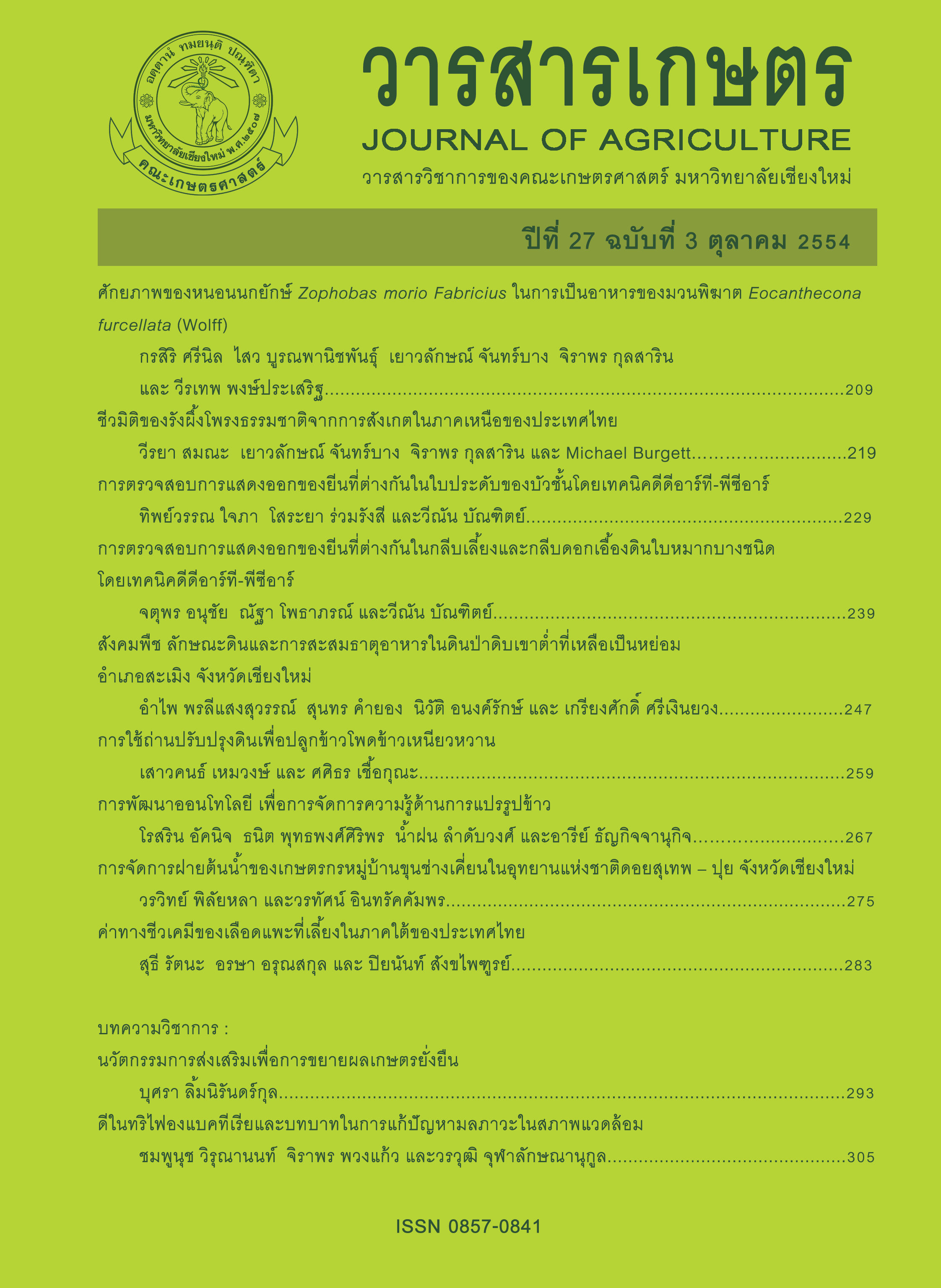ดีไนทริไฟอิ้งแบคทีเรียและบทบาทในการแก้ปัญหามลภาวะในสภาพแวดล้อม
Main Article Content
บทคัดย่อ
เกษตรกรรมในยุคโบราณเป็นการเพาะปลูกเพื่อให้ผลผลิตเป็นแหล่งอาหารและเป็นสิ่งแลกเปลี่ยนแทนเงินตรา การผลิตอาศัยธรรมชาติมากกว่าสารเคมี ในปัจจุบัน การเพาะปลูกอาศัยเทคโนโลยีและสารเคมีเป็นสิ่งช่วยเพิ่มผลผลิตและประหยัดเวลา อย่างไรก็ตามเทคโนโลยีทางการเกษตรโดยเฉพาะการใช้ปุ๋ยเคมีก่อให้เกิดมลภาวะต่อสิ่งแวดล้อมเป็นอันมาก โดยเฉพาะการปนเปื้อนสารเคมีลงสู่สิ่งแวดล้อม ในบทความนี้ได้กล่าวถึงจุลชีพกลุ่มที่มีบทบาทต่อการบำบัดการตกค้างของสารเคมีในสิ่งแวดล้อม โดยเฉพาะอย่างยิ่งกลุ่มดีไนทริไฟอิ้งแบคทีเรีย ซึ่งสามารถพบได้ทั้งพื้นที่เกษตรกรรมและในป่าไม้ และมีบทบาทเป็นผู้ย่อยสลายในวัฏจักรไนโตรเจน โดยเน้นไปที่หัวข้อหลักสี่หัวข้อคือ กระบวนการดีไนทริฟิเคชันและดีไนทริไฟอิ้งแบคทีเรีย สภาวะที่ทำให้แบคทีเรียเกิดกลไกที่จะหันมาใช้ไนเทรต เป็นตัวรับอิเลกตรอน และการประยุกต์ใช้ดีไนทริไฟอิ้งแบคทีเรียในการกำจัดของเสียอันตรายในงานวิทยาศาสตร์สิ่งแวดล้อม
Article Details
เอกสารอ้างอิง
เก็จกาญจน์ สมาธิวุฒิคุณ. 2546. การตรวจสอบยีนในไทรต์รีดักเทสในดีในทริไฟอิ้งแบคทีเรียโดยเทคนิคพีซีอาร์-อาร์เอฟแอลพี. วิทยานิพนธ์วิทยาศาสตรมหาบัณฑิต. จุฬาลงกรณ์มหาวิทยาลัย, กรุงเทพฯ. 119 หน้า.
กรมควบคุมมลพิษ. 2546. คู่มือวิชาการระบบบำบัดน้ำเสียแบบไม่ใช้อากาศ เล่มที่ 1. ศูนย์บริการวิชาการแห่งจุฬาลงกรณ์มหาวิทยาลัย. กรุงเทพฯ. 161 หน้า.
ฉันทนา จิบโคกหวาย. 2536. การปนเปื้อนของไนเทรตและฟอสเฟตในดิน น้ำ และตะกอนบริเวณสนามกอล์ฟติดกับอ่างเก็บน้ำหนองกลางดง จังหวัดชลบุรี. วิทยานิพนธ์วิทยาศาสตรมหาบัณฑิต สาขาวิชาวิทยาศาสตร์สภาวะแวดล้อม. จุฬาลงกรณ์มหาวิทยาลัย. กรุงเทพฯ. 193 หน้า.
สมศักดิ์ วังใน. 2524. จุลินทรีย์และกิจกรรมในดิน. ภาควิชาปฐพีวิทยา คณะเกษตร มหาวิทยาลัยเกษตรศาสตร์.กรุงเทพฯ. 193 หน้า.
สิรินันท์ ศรีดำ. 2552. การคัดเลือกแบคทีเรียดีในทริไฟอิงที่มีประสิทธิภาพเพื่อการบำบัดไนเทรตในน้ำทิ้งจากการเพาะเลี้ยงสัตว์น้ำชายฝั่ง (ระบบออนไลน์). แหล่งข้อมูล: http://www.pttsu.ac.th/rdi/Conail/POSTER19/P17.pdf (2 มิถุนายน 2554)
อาภาวรรณ พ่อค้า. 2552. การตรวจสอบแบคทีเรียดีในทริไฟอิงในหัวเชื้อจุลินทรีย์ผสมสาหรับการบำบัดไนเทรตด้วยเทคนิค Fluorescent In Situ Hybridization (FISH). (ระบบออนไลน์). แหล่งข้อมูล: http://www.pt.tsu.ac.th/rdi/ConAll/POSTER19/P19.pdf (2 มิถุนายน 2554)
อัมพิกา ภูวนะเสถียรฐ์. 2548. การตกค้างของสารไนเทรตและไนไทรต์ ในผักต่างชนิด ที่เพาะปลูกแบบเคมี แบบปลอดภัยจากสารพิษและแบบอินทรีย์. วิทยานิพนธ์วิทยาศาสตรมหาบัณฑิต. มหาวิทยาลัยมหิดล. กรุงเทพฯ. 152 หน้า.
Bradley, P.M., C.M. Aelion and D.A. Vroblesky. 1992. Influence of Environmental factors. on denitrification in sediment contaminated with JP-4 Jet Fuel. Ground Water 30: 843-848.
Delwiche, C.C. 1981. Denitrification, Nitrification, and Atmospheric Nitrous Oxide. New York: John Wiley and Sons, Inc. 298 p.
Falk, S., M. Hannig, C. Gilesche, R. Wardenga, M. Köster, K. Jürgens and G. Braker. 2007. nirS- containing denitrifier communities in the water column and sediment of Baltic Sea. Biogeosciences 4: 255-268.
Fukui, M., G. Harms, R. Rabus, A. Schramm, F. Widdel, K. Zengler, C. Boreham and H. Wilkes. 1999. Anaerobic degradation of oil hydrocarbons by sulfate-reducing and nitrate-reducing bacteria. Microbial Biosystems (Online): New Frontiers Proceedings of the 8th International Symposium on Microbial Ecology Bel. Available: http://plato.acadiau.ca/isme/Symposium12/fukui.PDF (June 3, 2011).
Gómez, M.A., E. Hontoria and J. González-López. 2002. Effect of dissolved oxygen concentration nitrate removal from groundwater using denitrifying submerged filter. Journal of Hazardous Materials 90: 267-278.
Gómez, M.A., B. Rodelas, F. Saez, C. Pozo, M. Victoria, M. Toledo, E. Hontoria and J.G. López. 2005. Denitrifying activity of Xanthobacter autotrophicus strains isolated from a submerged fixed-film reactor. Applied Microbiology and Biotechnology 68: 680-685.
Hess, A., P. Höhener, D. Hunkeler and J. Zeyer. 1995. Bioremediation of a diesel fuel contaminated aquifer: simulation studies in laboratory aquifer columns. Journal of Contaminant Hydrology 23: 329-345.
Hu, JY, S.L. Ong, W.J. Ng, F. Lu and X.J. Fan. 2003. A new method for characterizing denitrifying phosphorus removal bacteria by using three different types of electron acceptors. Water Research 37: 3463–3471.
Knight, V.K., H.B. Mitchell and M.M. Häggblom. 2009. Biotransformation of 3,5-dibromo-4-hydroxybenzonitrile under denitrifying, Fe (III) -reducing, sulfidogenic, and methanogenic conditions. Environmental Toxicology and Chemistry 22: 540-544.
L'hirondel, J.-L., A.A. Avery and T. Addiscott. 2006. Dietary Nitrate: Where is the risk? Environmental Health Perspectives 114: A458-A459.
Mille, G., L. Asia, M. Guiliano, L. Malleret and P. Doumenq. 2007. Hydrocarbons in coastal sediments from the Mediterranean sea (Gulf of Fos area, France). Marine Pollution Bulletin 54: 566-575. Rakhimova, E.R., A.L. Osipova and S.K. Zaripova. 2004. Purification of soil from oil pollutants with the use of denitrifying hydrocarbonoxidizing microorganisms. Applied Biochemistry and Microbiology 40: 563– 567.
Roger, K. 1982. Denitrification. Microbiological Reviews 46: 43-70.
Shi, H.P. and C.M. Lee: 2006. Combining anoxic denitrifying ability with aerobic-anoxic phosphorus-removal. examinations to screen denitrifying phosphorus-removing bacteria. International Biodeterioration and Biodegradation 57: 121–128.
Shinoda, Y., Y. Sakai, M. Ué, A. Hiraishi and N. Kato. 2000. Isolation and characterization of a new denitrifying spirillum capable of anaerobic degradation of phenol. Applied Environmental Microbiology 66: 1286–1291.
Song, K., S.-H. Lee and H. Kang. 2011. Denitrification rates and community structure of denitrifying bacteria in newly constructed wetland. European Journal of Soil Biology 47: 24-29.
Theerachat, M., C. Virunanon, S. Chulalaksananukul, N. Sinbuathong and W. Chulalaksananukul. 2011. NirK and nirS nitrite reductase genes from non-agricultural forest soil bacteria in Thailand. World Journal of Microbiology & Biotechnology 27: 999-1003.
Timmermans, P. and A. Van Haute. 1983. Denitrification with methanol: fundamental study of the growth and denitrification capacity of Hyphomicrobium sp. Water Research 17: 1249-1255.
Trois, C., F. Coulon, C. Polge de Combret, J.M.F. Martins and L. Oxarango. 2010. Effect of pine bark and compost on the biological denitrification process of non-hazardous landfill leachate: focus on the microbiology. Journal of Hazardous Materials 181: 1163-1169.
United State. Environmental Protection Agency. 1991. Basic Information about Nitrate in Drinking Water(Online).Available:http://water.epa.gov/drink/contaminants/basicinformation/nitr.ate .cfm (June 1, 2011)
Wachtmeister, A., T. Kuba, M.C.M. van Loosdrecht and J.J. Heijnen. 1997. Development of a sludge characterization assay for aerobic and denitrifying phosphorus removing sludge. Water Research 31: 471-478.
Ward, M.H., T.M. deKok, O. Levallois, J. Brender, G. Gulis and B.T. Nolan. 2005. Workgroup report: drinking -water nitrate and health-recent findings and research needs. Environmental Health Perspective 113: 1607-1614.
Wongsanit, J. 2009. Risk Assessment of Nitrate Contamination in Groundwater Using Geoinformatics. Dissertation for the Degree of Master of Science. Faculty of Science. Mahidol University. Nakhonpathom. 69 p.
World Health Organization. 2011. Water sanitation and health (Online) Available: http://www.who.int/water_sanitation_health/pu blications/en/index.html (June 1, 2011).
Zhou, Z., N. Takaya, M. Antonina, C. Sakairi and H. Shoun. 2001. 2001. Oxygen requirement for denitrification by the fungus Fusarium oxysporum. Archives Microbiology 175: 19-25.
Zhou, Y., M. Pijuan and Z.G. Yuan. 2007. Free nitrous acid inhibition on anoxic phosphorus uptake and denitrification by polyphosphate accumulating organisms. Biotechnolology and Bioengineering 98: 903-912.
Zhou, X., C. Chen, A. Wang, L.-H. K.-L. Liu Ho, N. Ren, and D.- J. Lee. 2011. Rapid acclimation of methanogenic granular sludge into denitrifying sulfide removal granules. Bioresource Technology (in press).


